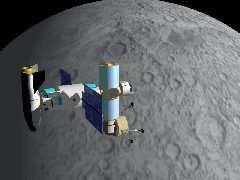
 |
|||||||
|
|
|
|
|
|
|
|
|
|
Sub-Orbital |
Orbital |
LEO Station |
Mission Statement |
Lunar Orbit |
Lunar Surface |
Mars and Beyond |
Those who think we should
bypass the moon for Mars underestimate the complexity and risk of a
Martian Expedition. To prepare for a three year journey to Mars, the
technologies and operations required to sustain an extended expedition far from the earth need refinement and practice. The moon is an
obvious place for this development work, as well as a destination in its own
right. Lunar orbit rendezvous offers the most cost-effective (or at
least lowest mass) option for lunar development. A small, normally uninhabited
station in a polar lunar orbit would be a great aid to a permanent presence at
one of the lunar poles.
This orbital base would consist of a "Mini-Mir" and a "Mini-bus" module and a Pod for cargo and module manipulation. All three components would be identical to those developed for earth orbital use, greatly lowering development costs.
For each construction or supply mission, a MOV will launch a lunar cargo vehicle derived from the LOV upper stage and massing up to 20 mt. This vehicle can deliver up to 6.25 mt of cargo to lunar orbit. Using a 90 day lunar swing-by insertion routine, the cargo capacity of this vehicle would reach 7.8 mt. The lunar cargo vehicle will be reusable, with enough fuel to return to earth, either re-entering or using the earth's atmosphere to aero-brake back into LEO for future missions.
For crewed missions, a modified version of the lunar cargo vehicle's propulsion module can propel a Orbital Crewed Vehicle into a lunar free-return trajectory. The modified OCV will include upgrade heat shields and a 2.9 mt methane/LOX propellant supply, enough to brake into lunar orbit and later return to earth.
The lunar orbital station will be the base for mating fuel tanks to shuttling lunar landers and for crew transfers between the OCV and the lunar lander. Similar base configurations could also support a geosynchronous earth orbit station or an outpost at any of the earth-moon or earth-sun Lagrange points.
All pages and images ©1999 - 2005
by Geir Lanesskog, All Right Reserved
Usage Policy
![]()